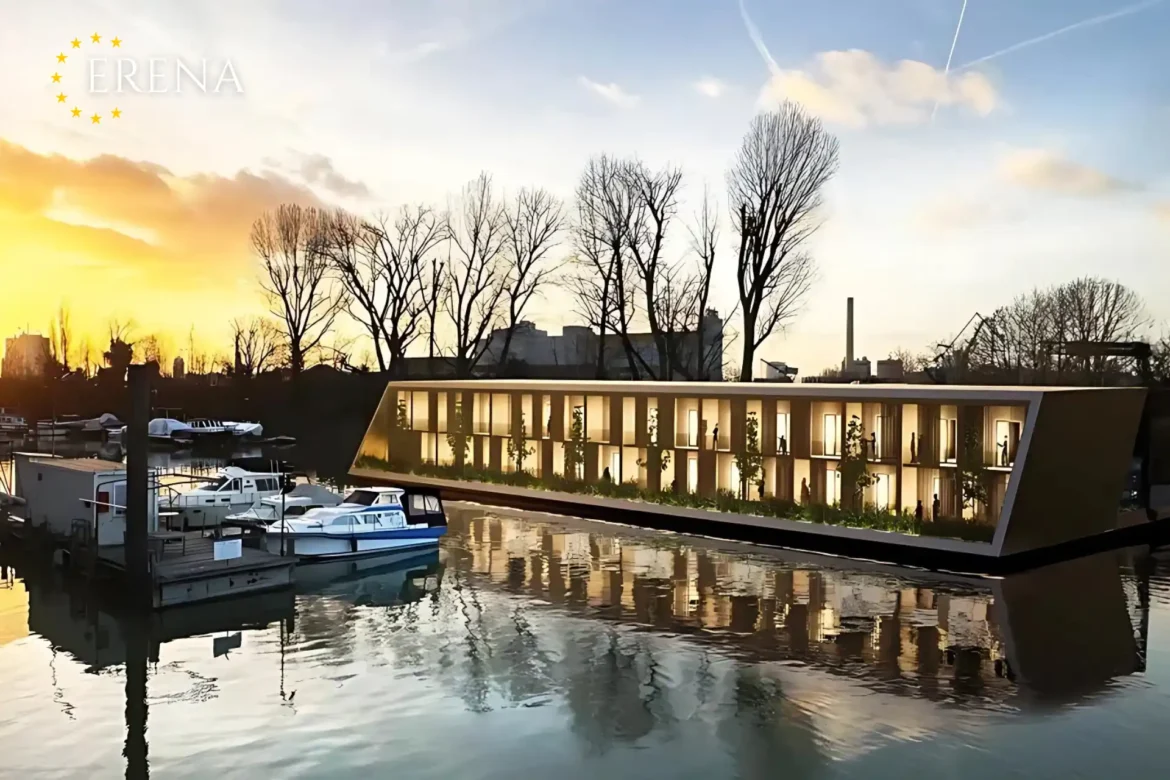The issue of housing shortages in Düsseldorf has remained pressing for many years. Rising rental prices, limited land resources, and stringent building requirements make finding new solutions increasingly challenging. As traditional approaches often fail to deliver the desired results, unconventional projects are gaining traction. One such innovative solution is the construction of floating townhouses on the city’s waterways.
A Growing Trend: Living on Water
The concept of living on water is not new, but over the past decade, it has become a genuine trend in several European cities. In Hamburg and Berlin, houseboats and floating homes have long been part of urban life. This phenomenon is driven by a desire for originality, proximity to nature, and the efficient use of available resources. In a time of land scarcity for housing projects, such initiatives are becoming particularly appealing. Additionally, they create a unique ambiance by combining the comforts of urban living with the tranquility of water environments.
Düsseldorf’s Potential for Floating Homes
Düsseldorf, situated along the Rhine and surrounded by numerous canals and inland waterways, holds significant potential for floating housing projects. Such developments can help reduce pressure on the housing market while adding diversity to the city’s architectural landscape. Promising areas for floating townhouse settlements have already been identified, and plans are underway to construct several residential complexes on the water in the coming years. These will combine aesthetic appeal with functional solutions to ensure comfortable living for residents.
Why Are Floating Homes Relevant?
1. Efficient Use of Space: In densely built urban areas, water spaces remain largely underutilized. Building on water provides an opportunity to create new housing without impacting existing infrastructure.
2. Proximity to Nature: Many city residents seek places where they can escape the hustle and bustle while staying close to nature. Floating homes perfectly balance urban conveniences and water serenity.
3. Architectural Flexibility: These projects offer architects the chance to employ innovative technologies and materials, creating homes that are both functional and visually striking.
4. Reducing Urban Pressure: Relocating part of the housing stock to waterways helps to ease the burden on overcrowded urban neighborhoods.
Technical and Legal Considerations
Developing floating townhouses requires meticulous planning, both from a technical and legal standpoint. Key aspects to consider include:
• Regulatory Framework: Housing on water is associated with several legal complexities. Regulations must address construction standards, environmental protection, and rights to use waterways.
• Infrastructure: Floating homes need to be integrated into urban systems, including water supply, electricity, and waste disposal. This requires the development of specialized solutions to ensure reliability and convenience.
• Environmental Safety: Planning and construction must account for the impact on water ecosystems. Conducting environmental assessments is an essential step.
• Social Integration: New projects must fit into the urban environment in a way that minimizes inconvenience to nearby residents and ensures accessibility for people with varying income levels.
Successful Examples
The implementation of similar projects in other European cities demonstrates their viability. In Hamburg, for instance, floating homes in the Wilhelmsburg district have become part of a comprehensive sustainable development approach. These homes are equipped with modern energy-saving systems and minimize environmental impact. Berlin is also seeing a growing interest in houseboats used as both temporary and permanent residences.
These examples can serve as inspiration for Düsseldorf. By leveraging existing experiences, the city can avoid common pitfalls and create unique residential complexes that meet high standards of quality and environmental friendliness.
Public Response
The idea of living on water generates significant interest among Düsseldorf residents. Many see these projects as an opportunity to live in a unique setting, enjoy water views, and stay closer to nature. However, concerns also exist. Key issues include the cost of construction and maintenance, as well as practical aspects such as the stability of buildings and their accessibility during adverse weather conditions.
For successful implementation, it is essential to engage the public in dialogue. Transparent planning, communication of benefits and risks, and involving residents in the discussion process can foster a positive attitude and minimize potential conflicts.
Prospects and Challenges
Floating townhouses in Düsseldorf are not just a solution to current housing problems but also a significant step in developing the city’s urban environment. These projects offer several promising opportunities:
• Innovation Stimulation: New construction technologies for water-based projects can pave the way for further innovation in architecture.
• Increased Tourism Appeal: Unique floating homes can attract tourists and raise Düsseldorf’s profile as a modern and dynamically developing city.
• Environmental Advancement: Many such projects incorporate renewable energy sources and minimize environmental impact, making them an essential part of sustainability strategies.
At the same time, challenges accompanying these initiatives must be addressed. These include adhering to strict environmental standards, finding effective solutions for integrating infrastructure, and working to reduce construction costs.
Floating townhouses are not just an architectural novelty but a practical solution to Düsseldorf’s housing shortage. They allow for the productive use of water spaces, creating new, comfortable, and eco-friendly residential areas. Successfully implementing such projects requires coordinated efforts from various departments, attracting investors, and considering the needs of the local community.
Düsseldorf has the potential to become a role model for other cities by addressing this issue with responsibility and creativity. Incorporating floating homes into the urban infrastructure will not only solve part of the housing problem but also give the city a new, forward-thinking image that reflects the spirit of modernity and innovation.
Floating Townhouses in Düsseldorf: A Creative Solution to the Housing Shortage
499

